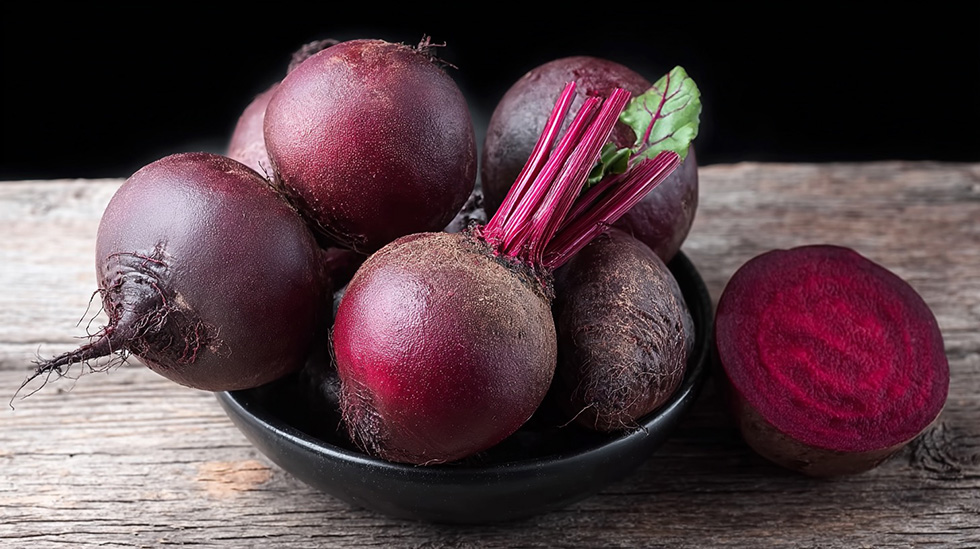On what tree do beetroots grow?
Beetroot, also known as red beetroot or beetroot turnip (Latin *Beta vulgaris* var. *conditiva*), is a particularly colourful and healthy root vegetable that has been on the table in European and Hungarian kitchens for centuries. It is native to the eastern Mediterranean and was known to the ancient Greeks – and even offered to the gods! And the Romans were fond of eating not only the root but also the leaves.

Its importance in the kitchen: 4/5
Although not a staple vegetable like potatoes or carrots, beetroot is an essential vegetable if you want to create healthy, colourful dishes with character. In Hungary, it’s best known as a pickle, but the culinary revolution has redefined it: it can be used in carpaccio, baked beetroot, beetroot creams, soups and even desserts!
Which parts are edible?
The most commonly eaten part of beetroot is the tuber, which is delicious raw, cooked, baked or pickled. The fresh, tender beetroot leaves are also edible – and healthy! It’s also great in salads and green smoothies. Important: the leaves are good when they are fresh, bright green and not wilted.
The skin of the beetroot should be removed before eating, but it is not poisonous – after cooking, the skin can be easily peeled off.
Health superpowers 🦸♀️
Beetroot is not considered a super vegetable for nothing! The nitrates it contains can help lower blood pressure, improve circulation, and support endurance – it’s a favourite among athletes! It is also rich in folic acid, vitamin C, iron and fibre.
Folk medicine also counts it as a blood healer and liver cleanser. It is also known to have digestive and anti-inflammatory effects.
Growing and season
Beetroot is grown outdoors and does not require greenhouse conditions. It is a common crop throughout Europe, with large quantities grown mainly in Eastern Europe, France, Germany and Poland.
Beetroot is also an important vegetable in Hungary, especially in late summer – autumn you can find fresh, domestic beetroot in the markets. Its season lasts from the end of July until October. In winter, stores tend to stock domestic or imported products.
How to choose the best beetroot?
When shopping, look out for:
- Make it hard to the touch – soft tubers are already losing moisture.
- The skin should be smooth and free of wrinkles.
- The smaller the better! Beets that are too big taste woodier and less sweet.
- If the leaf is on: it should be bright green, not wilted.
How to store it at home?
Beetroot is best stored in a cool, dark place – it will keep for up to two weeks in the vegetable drawer of your fridge. If you want to keep them longer, remove the leaves and store the tubers separately. Cooked or baked in the fridge, it will keep its quality for 3-5 days. You can also freeze them, but be sure to cook them first.
In the kitchens of the world
Beetroot has become a world star! The Russians and Ukrainians cook it in a peppercorn soup, which is a sour, meaty beetroot soup. The French love it in salads, the British serve it as a pickled pickle, and the Scandinavians mix it with horseradish. In India it also appears in curries. More recently, beetroot brownies and beetroot lattes have become popular in hipster cafés. 😄
Best-known recipe: classic beetroot salad
No real winter lunch without the Hungarian classic beetroot salad! It’s easy to prepare:
- Grate cooked, peeled beetroot
- Season with vinegar, sugar, salt, cumin seeds
- Perfect pickle for meats after a few hours of chilling
Tips for using it in the kitchen
You can’t just cook beetroot – try it roasted! Wrapped in aluminium foil and baked at 180 °C for 1 hour, it retains its sweet taste.
Spices that suit him:
- cumin
- balsamic vinegar
- thyme
- rosemary
- garlic
- torma
- lemon juice
Spices to avoid:
- basil (rarely harmonises)
- cinnamon (too dominant)
Creative tip: try beetroot in a smoothie with apple and ginger – it’s an immune-booster! 💪
In summary
Beetroot is not just one vegetable among many – it’s a colourful, healthy and versatile ingredient worth rediscovering! Whether you’re looking for traditional flavours or trying something extra, beetroot is always there for you – and it’s good for your blood pressure too! 😉
